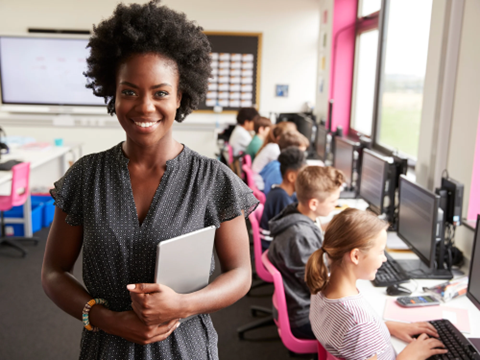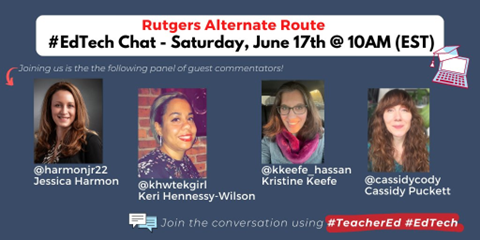Teachers Enhance Learning and Productivity Using Technology

Technology has become an integral part of education, transforming traditional classrooms into dynamic learning environments. Its benefits are undeniable for both students and teachers. For students, technology can make learning more interactive and fun, which can help students stay focused and interested in the material. It can also help students learn how to work together effectively and complete collaborative projects more efficiently. For teachers, technology makes it easier to differentiate instruction to meet the needs of all students, including students with learning disabilities who require accommodation.
In addition, technology can help teachers save time by automating tasks such as grading and record-keeping so that they can focus on instruction. In a recent social media discussion hosted by Rutgers Alternate Route, new teachers enrolled in the program explored the use of technology in classroom instruction and professional practice, shedding light on how technology can enhance their students’ learning experiences but also create classroom challenges.
Technology as a tool for active learning
Many educators in the chat use technology daily in their classrooms and highlighted its role in promoting active learning and creating immersive experiences for students.
For example, @marijadraskic1 uses Google Classroom, Google Slides, and Jamboard for assignments, as does @MrsGreco26 who organizes her lessons with Google Slides.
Other educators in the chat use technology to gamify learning for students and, thereby, increase engagement. @JoaCac2117 uses technology to have students complete anticipatory guides and Kahoot for a fun and competitive end-of-unit review.
Similarly, @MsGrassoMusic uses games like Blooket to reinforce ideas and concepts. By leveraging the visual advantages and interactivity inherent in technology, educators can facilitate better comprehension which fosters increased learning for students.

Integrating Technology with Learning Outcomes
Several educators, such as @khwtekgirl, @TamaraColbert6, and @JoaCac2117, discussed the importance of aligning technology use with learning outcomes. They stressed that technology should support the achievement of educational standards and learning goals.
Whether it’s using interactive games like Blooket and Quizizz, anticipatory guides, or Kahoot for end-of-unit reviews, these educators highlighted the significance of the "why" behind technology integration. They understand that technology should reinforce learning objectives and the importance of considering whether technology is needed for a specific learning activity or desired outcome.
Diverse Technological Tools in Practice
The chat allowed educators to gain a sense of the various technological tools they use in their classrooms. @KellyHa118 mentioned using the Promethean board for lesson projection and game-based learning, while @MAConnelly34315 discussed using technology for simulations, labs, and collaborative projects. @AndreaZarr43135 listed various tools like iReady, Prodigy, Typing Club, FlipGrid, and Kahoot in her second-grade classroom.
These educators teach a range of grades and subjects. Their responses indicate that technology can be integrated across various subjects and activities, underscoring its versatility in enhancing different facets of education.
Overcoming Challenges in Technology Integration
Amid the advantages of technology, educators also acknowledged challenges in its seamless implementation. @AndreaZarr43135 expressed limitations due to time-consuming setup processes with QR codes, headphones, and computers in her second-grade class. @XimenaV33473803, a first-year teacher, is still learning software and websites that her students use. @CaraConniff finds it challenging to keep high school students focused on the technology that she wants them to be using. @becmarcinkobcba believes that many of her special education students are addicted to iPads, which makes it harder to use them in class.
Other challenges include students not having access to the internet at home, limited resources, and technology being a distraction for students. Some educators in the chat prefer to use technology for simulations, labs, or allowing student collaboration on projects.
Technology should make teachers' jobs easier rather than frustrate them, so solutions to these challenges must be addressed. Teachers need to be adequately prepared and trained to use technology effectively. According to a report by the Office of Educational Technology, educator preparation and professional development programs must do more to ensure their teacher candidates have the technology competencies required for today’s classrooms.
Similarly, administrators responsible for training new teachers should support them with the professional experiences needed to enhance learning for students through technology. Teachers can also leverage support from mentors and colleagues to help expand their ed-tech knowledge and identify strategies that support their efforts to effectively integrate technology in their classrooms. Social media is a great resource for locating veteran teachers willing to lend a helping hand to new teachers as evidenced by the chat’s guest commentators who offered their insights during the Saturday morning event.

Learn more about the chat using the curated posts in our Wakelet collection found here.

 Heather Ngoma has over 25 years of experience collaborating with educators across New Jersey to drive education innovation. She currently serves as the Director of the Rutgers-GSE Alternate Route Program in the Department of Learning and Teaching, a program which helps career changers, recent college graduates, and other aspiring education professionals become licensed teachers in New Jersey. Follow her on Twitter @heatherngoma.
Heather Ngoma has over 25 years of experience collaborating with educators across New Jersey to drive education innovation. She currently serves as the Director of the Rutgers-GSE Alternate Route Program in the Department of Learning and Teaching, a program which helps career changers, recent college graduates, and other aspiring education professionals become licensed teachers in New Jersey. Follow her on Twitter @heatherngoma.





